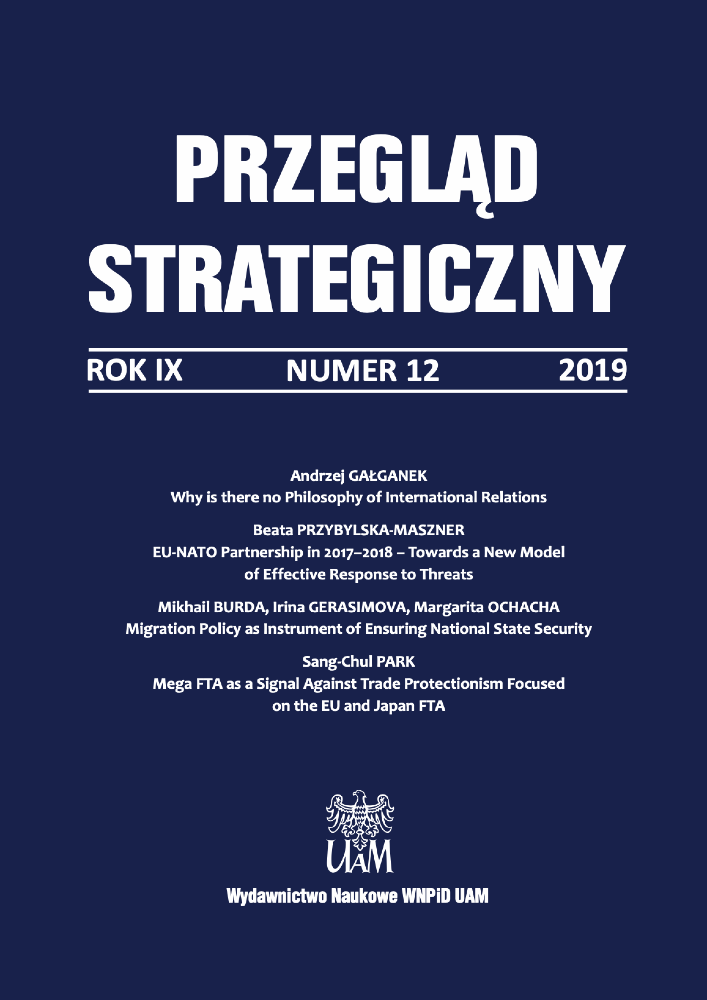Abstract
The collapse of the Cold-War order in Europe brought about a radical change in the global security system. The dissolution of the Soviet Union and the disbandment of the Warsaw Pact created a situation where the only serious and effective guarantee of stability in Europe was NATO. Central European states, which until that time had been subordinated to the USSR, unequivocally and consistently chose to pursue the Euro-Atlantic direction in their security policy. The decision resulted in their gaining full, even though gradual, membership in the Alliance during the years 1999–2004. The accession process was first completed by the Czech Republic, Hungary and Poland. Central Europe is not free from dangers stemming from national and supranational transformations. NATO is facing the need to increase its activity and systematically ensure joint cooperation and security guarantees as regards all its member states. This is primarily caused by a revival of Russia’s superpower ambitions under the presidency of Vladimir Putin and an escalation of terrorism and cyberspace threats. The decisions and practical actions related to biennial NATO summits are of vital importance in this respect. The text presented here is an analysis of the security of Central Europe within NATO structures in the light of the last three NATO summits: in Newport in 2014, in Warsaw in 2016 and in Brussels in 2018.
References
Belkin P. (2016), NATO’s Warsaw Summit: In Brief, Washington.
Bell R. (2018), The Challenges of NATO Nuclear Policy, FIIA Working Paper, October.
Blum J., Potrafke N. (2019), Does a Change of Government Influence Compliance with International Agreements? Empirical Evidence for the NATO Two Percent Target, Defence and Peace Economics.
Broke-Holland L., Mills C. (2014), NATO Wales Summit 2014: Outcomes, London.
Deni J. R. (2014), NATO’s New Trajectories after the Wales Summit, Parameters, No. 44.
Durkalec J. (2018), The 2018 U.S. Nuclear Posture Review, NATO’s Brussels Summit and Beyond, Livermore.
Flockhart T. (2015), Preparing for NATO’s Warsaw Summit. The Challenges of Adapting to Strategic Change, Copenhagen.
Franke U. (2018), Roundtable Feature: Now What? Lessons for Europe from the NATO Summit, “Texas National Security Review”, Vol. 1, Issue 4, pp. 137–139.
Friis K. (2017), NATO and the Collective Defence in the 21th Century. An Assessment of the Warsaw Summit, London.
Fryc M. (2016), From Wales to Warsaw and Beyond: NATO’s Strategic Adaptation to the Russian Resurgence on Europe’s Eastern Flank, “Connetions: The Quortelly Journal”, No. 4, pp. 45–65.
Giegerich B. (2016), NATO’s Strategic Adaptation, the Warsaw Summit and Beyond, “The Polish Quarterly of International Affairs”, Issue 1, pp. 61–68.
Gizicki W. (2013), A Security Community. Poland and Her Visegrad Allies: the Czech Republic, Hungary and Slovakia, Lublin.
Glatz R. L., Zapfe M. (2016), NATO Defence Planning between Wales and Warsaw, Berlin.
Herzog S. (2010), Western Values and Strategic Interest? Evaluating Potential Georgian Membership in NATO, “Central European Journal of International and Security Studies”, Vol. 4, No. 1, pp. 123–139.
Howorth J. (2017), EU–NATO cooperation: the key to Europe’s security future, “European Security”, Vol. 26, Issue 3, pp. 454–459.
Ivančík R., Nečas P. (2017), Towards Enhanced Security: Defense Expenditures in the Member States of the European Union, “Journal of Security and Sustainability Issues”, Vol. 6, No. 3, pp. 373–382.
Kammel A. H., Zyla B. (eds.) (2018), Peacebuilding at Home. NATO and its ‘New’ Member States after Crimea, Baden-Baden.
Keil S., Oliver T. (2016), What Would a US Policy of “restraint” mean of the Warsaw NATO Summit, “International Politics Reviews”, Vol. 4, Issue 1, pp. 31–35.
Koziej S., Pietrzak P. (2014), NATO Summit in Newport, “Bezieczeństwo Narodowe”, No. 31, pp. 11–29.
Křĭž Z., Fridrichová K. (2015), Libya and Criteria for Humanitarian Intervention, “Czech Journal of Political Science”, No. 3, pp. 183–199.
Larsen J. A. (2016), Time to Face Reality: Priorities for NATO’s 2016 Warsaw Summit, Research Paper, NATO Defence College, No. 126.
Lasconjarias G. (2014), NATO’s Posture after the Wales Summit, IAI Working Papers, No. 14.
Lesser I. (2016), The NATO Warsaw Summit: Reflections on Unfinished Business, The International Spectator, “Italian Journal of International Relations”, Vol. 51, Issue 4, pp. 131–133.
Mattelaer A. (2016), The NATO Warsaw Summit: How to Strengthen Alliance Cohesion, “Strategic Forum”, No. 296.
Nünlist Ch., Zapfe M. (2014), NATO after Wales: Dealing with Russia – Next Steps, Zürich.
Smith M. A., Timmins G. (eds.) (2018), Building a Bigger Europe: EU and NATO Enlargement in Comparative Perspective, London.
Suer T. (2016), Just Leave It: NATO’s Nuclear Weapons Policy at the Warsaw Summit, “Arms Control Today”, Vol. 45, No. 5, pp. 16–21.
Sydoruk T., Tyshchenko D. (2018), Central Europe on Russia-Ukraine Conflict. Positions and Responses, “Central European Journal of International and Security Studies”, Vol. 12, Issue 3, pp. 81–105.
Terlikowski M. (2018) Newport – Warsaw – Brussels: NATO in Defence of Peace in Europe, Warsaw.
Upadhyay D. K. (2016), NATO Warsaw Summit: Outcomes and Implications, ISSUE Brief, 2 August.
Wolff A. T. (2015), The future of NATO enlargement after the Ukraine crisis, “International Affairs”, Vol. 91, Issue 5, pp. 1103–1121.

